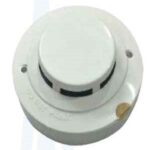Your list is empty, add products to the list to send a request
Which Fire Extinguisher Is Best for a House?

30
Jun
Fires can start in seconds, but a properly chosen fire extinguisher can prevent a disaster. Every home should have at least one functional fire extinguisher that’s easy to use and effective on the most common household fires.
In this guide, we’ll help you understand which fire extinguisher is best for a house, why ABC fire extinguishers are the most recommended, and how to select the right model for your space. We’ll also answer some frequently asked questions and provide a reliable product option to consider.
Why Every House Needs a Fire Extinguisher
Household fires can be caused by:
- Cooking oil catching fire in the kitchen
- Electrical malfunctions from appliances
- Flammable liquids like cleaning agents
- Accidental ignition from candles or cigarettes
Having a fire extinguisher readily available can:
- Help control small fires before they spread
- Save lives by giving time to evacuate
- Minimize property damage
What Types of Fire Extinguishers Exist?
There are several types of fire extinguishers, each designed for specific fire classes:
- Water – Class A (paper, cloth, wood)
- Foam – Class A & B (liquids like petrol, paint)
- CO2 – Class B & C (flammable liquids and electrical)
- Dry Powder (ABC) – Class A, B & C (multi-purpose)
- Wet Chemical – Class K/F (kitchen oil/fat fires)
For home use, multi-class extinguishers are best to handle various fire types.
Which Fire Extinguisher Is Best for a Home?
The most suitable extinguisher for home safety is the ABC fire extinguisher. It is a versatile, dry chemical extinguisher that covers the most common fire risks found in houses.
Why ABC is best for homes:
- Covers Class A (solid combustibles), Class B (flammable liquids), and Class C (electrical)
- Easy to use with no special training required
- Safe on a wide range of household materials
- Cost-effective and readily available
What Type of Fire Extinguisher Is Needed for Home Use?
An ABC-rated extinguisher, ideally:
- Should be at least 5–6 kg in capacity
- Must be ISI certified to ensure safety standards
- Needs to be stored in accessible locations (kitchen, hallway, garage)
Homes with specific risks like a deep fryer or home lab may need additional Class K or CO2 extinguishers respectively.
What Type of Fire Extinguisher Is Used in Residential Buildings?
Most residential buildings, including apartments and gated communities, use:
- ABC fire extinguishers as general-purpose units
- CO2 extinguishers near electrical panels and server rooms
ABC fire extinguishers offer the best combination of reliability and ease of use in living environments.
Benefits of Using an ABC Fire Extinguisher at Home
- Multi-purpose use: effective on solids, liquids, and electrical fires
- Easy to operate: nozzle design and pressure gauge for user convenience
- Low maintenance: inspect monthly and service annually
- Dry chemical agent: quickly smothers flames by cutting off oxygen
Where to Place Fire Extinguishers in a House
Strategic placement matters. Ideal locations include:
- Kitchen – high fire risk zone
- Near electrical panels – in utility rooms or garages
- Bedrooms or hallways – for quick nighttime access
- Exit points – for a safe escape route while using the extinguisher
Always keep extinguishers wall-mounted and easily visible.
Product Spotlight: Safex ABC 6 Kg Fire Extinguisher
The Safex ABC Fire Extinguisher is a top-rated choice for residential use.
Key features include:
- Covers Class A, B, and C fire types
- ISI-certified for Indian safety standards
- Wall-mountable with discharge hose and pressure gauge
- Ideal for kitchens, garages, and living spaces
Its 6 kg capacity provides extended coverage for larger rooms or multi-story homes.
How to Use a Home Fire Extinguisher
Use the PASS method:
- Pull the pin to unlock the extinguisher
- Aim at the base of the fire
- Squeeze the handle slowly and evenly
- Sweep side to side to cover the fire zone
Only attempt to extinguish if the fire is small and you have a safe exit path.
Maintenance Tips for Home Fire Extinguishers
- Inspect monthly for damage or pressure loss
- Test annually by professionals
- Replace or recharge after any use
- Replace every 10–12 years even if unused
Proper upkeep ensures your extinguisher performs when it matters.
Conclusion: Be Prepared, Stay Protected
Choosing the right fire extinguisher for your home is not just about compliance—it’s about protecting your loved ones and property. The ABC extinguisher, especially models like the Safex ABC 6 Kg Fire Extinguisher, provides reliable, multi-purpose protection for typical household fire risks.
Invest in fire safety now and gain the peace of mind that comes with being prepared.
FAQs
1. Which fire extinguisher is best for a home?
An ABC dry powder extinguisher is best for most homes, as it covers fires involving solid combustibles, flammable liquids, and electrical equipment.
2. What type of fire extinguisher is needed for home use?
A multi-class ABC extinguisher of 5–6 kg is ideal. Depending on the home’s setup, a CO2 or wet chemical extinguisher may also be useful.
3. What type of fire extinguisher is used in residential buildings?
Residential buildings commonly use ABC fire extinguishers for general protection and CO2 extinguishers near electrical systems.
Don’t wait for a fire emergency to realize what you’re missing.
Shop the Safex ABC Fire Extinguisher from Fire Supplies, and secure your home with one of the best-rated fire safety tools available.



























